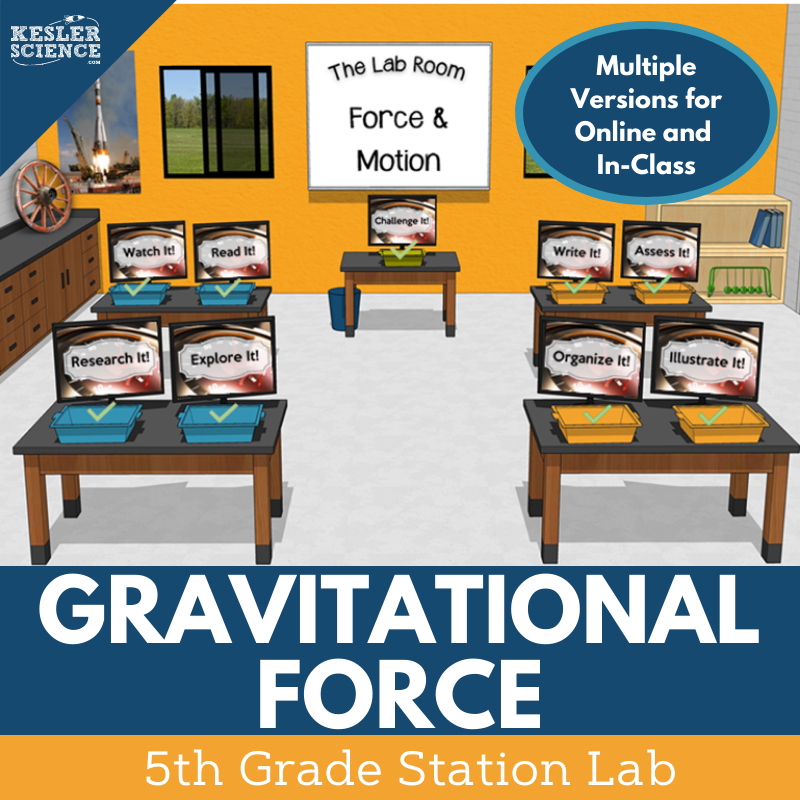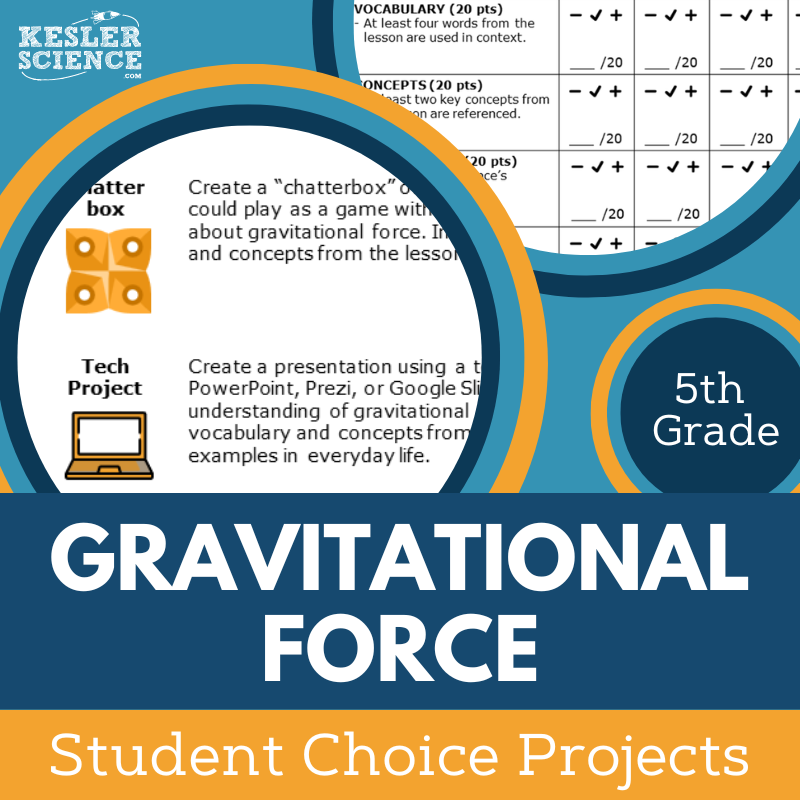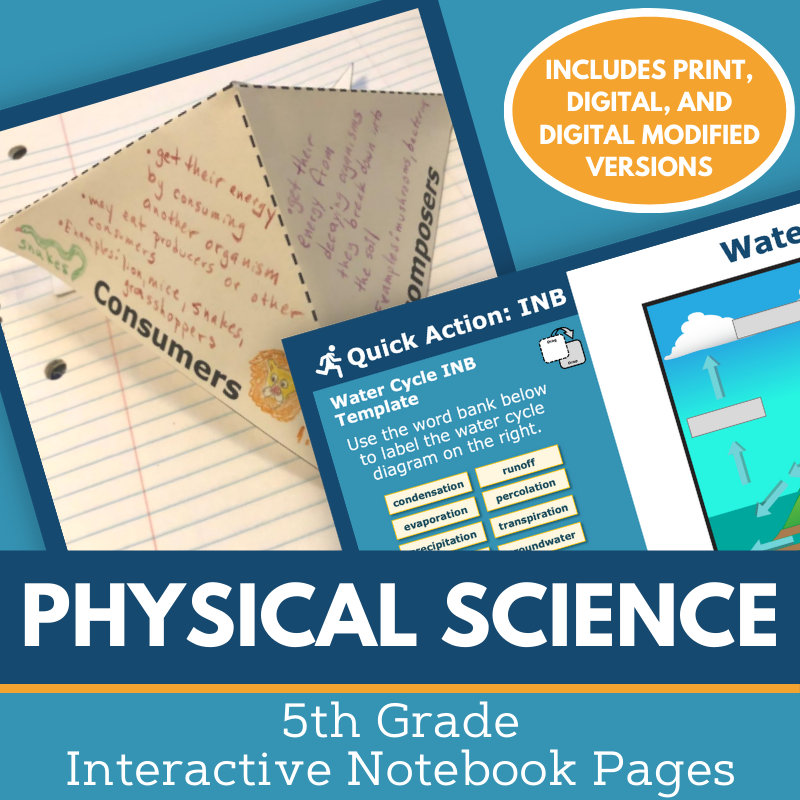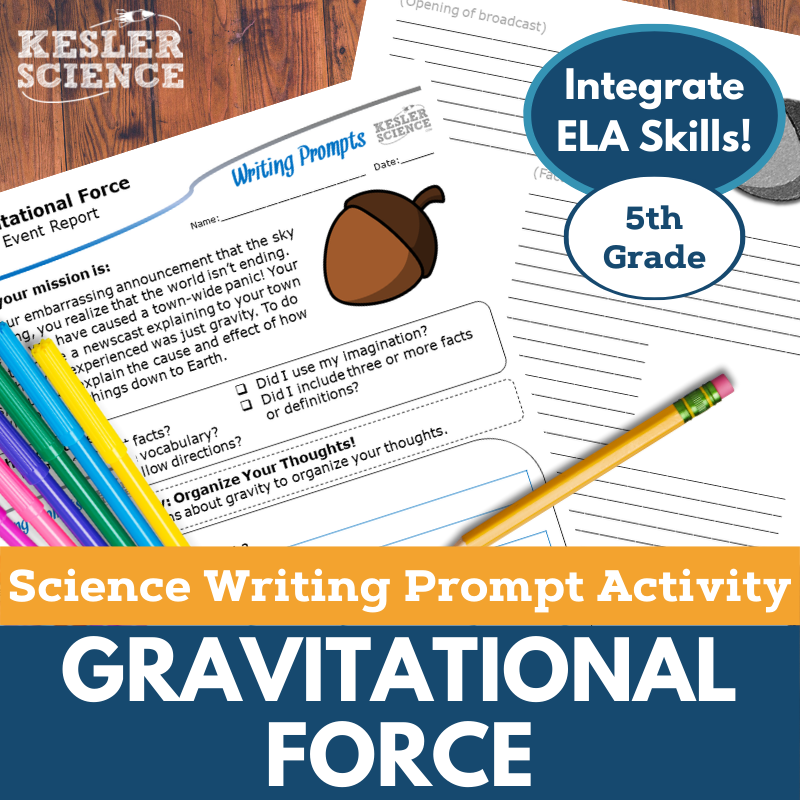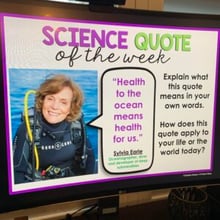Gravitational Force Activities for 5th Grade Science
The Kesler Science Gravitational Force 5E Lesson engages elementary students in understanding gravitational force through a structured, student-led approach. The resources below will give students a comprehensive understanding of gravitational force. All of the following materials are also included in the Kesler Science Membership.
The Kesler Science Gravitational Force 5E Lesson is a comprehensive unit on gravitational force designed for elementary students. It includes editable presentations, worksheets, choice projects, and assessments, all requiring low to no prep. This differentiated, student-led lesson engages learners while allowing teachers to focus on student success.
Students explore key questions about the direction and consistency of Earth's gravitational force. The lesson follows the 5E Model, providing structured learning through engagement activities, a hands-on station lab, and flexible digital and print resources. The Exploration phase features a student-led station lab with nine interactive stations, offering multimodal learning through experiments, reading passages, videos, research, and hands-on categorization activities.
Explanation includes editable PowerPoints, interactive notebooks in English and Spanish, and guided note-taking templates. Elaboration allows students to extend their learning through choice projects, while Evaluation provides assessments aligned with STAAR 2.0, review questions, and practice worksheets.
This lesson supports flexible learning, making it ideal for both in-person and virtual instruction. Spanish translations of vocabulary, reading passages, and notebook pages ensure accessibility for diverse learners.
The Kesler Science Gravitational Force 5E Lesson is a comprehensive unit on gravitational force designed for elementary students. It includes editable presentations, worksheets, choice projects, and assessments, all requiring low to no prep. This differentiated, student-led lesson engages learners while allowing teachers to focus on student success.
Students explore key questions about the direction and consistency of Earth's gravitational force. The lesson follows the 5E Model, providing structured learning through engagement activities, a hands-on station lab, and flexible digital and print resources. The Exploration phase features a student-led station lab with nine interactive stations, offering multimodal learning through experiments, reading passages, videos, research, and hands-on categorization activities.
Explanation includes editable PowerPoints, interactive notebooks in English and Spanish, and guided note-taking templates. Elaboration allows students to extend their learning through choice projects, while Evaluation provides assessments aligned with STAAR 2.0, review questions, and practice worksheets.
This lesson supports flexible learning, making it ideal for both in-person and virtual instruction. Spanish translations of vocabulary, reading passages, and notebook pages ensure accessibility for diverse learners.
Engage your 5th-grade students in a hands-on, student-led exploration of gravitational force with this interactive station lab. Designed to promote independent learning, this low-prep resource allows students to support an argument that Earth's gravitational force pulls objects downward.
The lab features nine differentiated stations, including a challenge station for early finishers. Students interact with new concepts through videos, readings, hands-on demonstrations, and research-based tasks. They demonstrate their understanding by organizing information, illustrating models, writing responses, and completing assessments. The digital version includes interactive activities using PowerPoint or Google Slides, and Spanish and English reading passages provide differentiated support.
Perfect for in-class or virtual learning, this engaging resource encourages critical thinking and active participation.
Engage your 5th-grade students in a hands-on, student-led exploration of gravitational force with this interactive station lab. Designed to promote independent learning, this low-prep resource allows students to support an argument that Earth's gravitational force pulls objects downward.
The lab features nine differentiated stations, including a challenge station for early finishers. Students interact with new concepts through videos, readings, hands-on demonstrations, and research-based tasks. They demonstrate their understanding by organizing information, illustrating models, writing responses, and completing assessments. The digital version includes interactive activities using PowerPoint or Google Slides, and Spanish and English reading passages provide differentiated support.
Perfect for in-class or virtual learning, this engaging resource encourages critical thinking and active participation.
The Gravitational Force Student Choice Projects lesson allows 5th-grade students to select a project that aligns with their preferred output style. A project page outlines six student-led options plus a “design your own” project, all with a grading rubric for teacher, peer, or self-assessment.
These flexible, multimodal projects provide creative ways for students to demonstrate their understanding. Two versions of the project page support differentiation, with modified options for students needing remediation and challenge opportunities for advanced learners. Teachers can adjust the rubric to fit grading needs and assign a combination of projects for deeper exploration.
The projects require standard classroom supplies like paper, markers, and scissors, with many options available for digital completion. Some crafting materials may be useful for model-building.
The Gravitational Force Student Choice Projects lesson allows 5th-grade students to select a project that aligns with their preferred output style. A project page outlines six student-led options plus a “design your own” project, all with a grading rubric for teacher, peer, or self-assessment.
These flexible, multimodal projects provide creative ways for students to demonstrate their understanding. Two versions of the project page support differentiation, with modified options for students needing remediation and challenge opportunities for advanced learners. Teachers can adjust the rubric to fit grading needs and assign a combination of projects for deeper exploration.
The projects require standard classroom supplies like paper, markers, and scissors, with many options available for digital completion. Some crafting materials may be useful for model-building.
The 5th Grade Physical Science Interactive Notebook is an essential resource for teachers looking to enhance student engagement in elementary physical science. This comprehensive set includes both print and digital versions, making it adaptable for traditional classrooms, 1:1 environments, and distance learning.
The digital version features a unique interactive notebook PowerPoint that can be uploaded to Google Slides and shared via MS Teams, Schoology, or Canvas. It includes reflection pages for comprehension, space for student notes, a teacher answer key, and a modified version for students with accommodations. The paper version provides blank interactive notebook templates, pre-filled templates for students needing modifications or who were absent, and color photos demonstrating template use.
Topics covered include particles of matter, conservation of mass, properties of matter, formation of new substances, gravitational force, the Sun’s energy, classifying matter, mixtures, solutions, uses of energy, closed circuits, reflection and refraction, and testing forces.
These interactive notebook templates are also available in the Kesler Science 5E Lessons, which include presentations, notes, homework, student projects, station labs, assessments, and engagement activities.
The 5th Grade Physical Science Interactive Notebook is an essential resource for teachers looking to enhance student engagement in elementary physical science. This comprehensive set includes both print and digital versions, making it adaptable for traditional classrooms, 1:1 environments, and distance learning.
The digital version features a unique interactive notebook PowerPoint that can be uploaded to Google Slides and shared via MS Teams, Schoology, or Canvas. It includes reflection pages for comprehension, space for student notes, a teacher answer key, and a modified version for students with accommodations. The paper version provides blank interactive notebook templates, pre-filled templates for students needing modifications or who were absent, and color photos demonstrating template use.
Topics covered include particles of matter, conservation of mass, properties of matter, formation of new substances, gravitational force, the Sun’s energy, classifying matter, mixtures, solutions, uses of energy, closed circuits, reflection and refraction, and testing forces.
These interactive notebook templates are also available in the Kesler Science 5E Lessons, which include presentations, notes, homework, student projects, station labs, assessments, and engagement activities.
The Gravitational Force Science Writing Activity engages 5th-grade students in a news event report exercise to reinforce their understanding of gravitational force. Aligned with NGSS 5-PS2-1, this creative, low-prep activity enhances science reasoning and writing skills in both print and digital formats, making it ideal for in-person and virtual learning.
This resource includes teacher directions with an answer guide, project ideas, and rubrics. It offers full-sized and half-sheet handouts featuring the writing prompt, student self-check, pre-writing strategy, and layout templates. A digital interactive version is available in PowerPoint and can be used in Google Slides for remote learners.
Perfect for cross-curricular activities, pre-test assessments, student choice projects, early finisher enrichment, extra credit, and differentiation, this writing prompt also works well for TELPAS samples and make-up work. Designed for engagement and flexibility, it supports students in strengthening their scientific argumentation skills.
The Gravitational Force Science Writing Activity engages 5th-grade students in a news event report exercise to reinforce their understanding of gravitational force. Aligned with NGSS 5-PS2-1, this creative, low-prep activity enhances science reasoning and writing skills in both print and digital formats, making it ideal for in-person and virtual learning.
This resource includes teacher directions with an answer guide, project ideas, and rubrics. It offers full-sized and half-sheet handouts featuring the writing prompt, student self-check, pre-writing strategy, and layout templates. A digital interactive version is available in PowerPoint and can be used in Google Slides for remote learners.
Perfect for cross-curricular activities, pre-test assessments, student choice projects, early finisher enrichment, extra credit, and differentiation, this writing prompt also works well for TELPAS samples and make-up work. Designed for engagement and flexibility, it supports students in strengthening their scientific argumentation skills.
The WIKI Tickets© Physical Science Set offers engaging, formative assessments for 3rd–5th grade science. This set includes 37 assessments, each available in five formats: a full-screen display for projection, three printable handout sizes, and an interactive digital version compatible with PowerPoint and Google Slides.
Aligned with NGSS and TEKS standards, these assessments cover key topics in chemistry, energy, and force and motion, ensuring comprehensive science understanding. Topics include states of matter, forms of energy, gravitational force, formation of new substances, uses of energy, and the Sun's energy. Each standard has at least one assessment, with some topics featuring multiple tickets. A table of contents file is included for alignment reference.
WIKI Tickets© can be used both in the classroom and virtual learning environments. Teachers can project them for whole-class participation, distribute printed copies, or assign digital versions in 1:1 settings. Designed to be colorful and engaging, these assessments work as exit tickets, bellringers, or quick comprehension checks to gauge student progress.
The WIKI Tickets© Physical Science Set offers engaging, formative assessments for 3rd–5th grade science. This set includes 37 assessments, each available in five formats: a full-screen display for projection, three printable handout sizes, and an interactive digital version compatible with PowerPoint and Google Slides.
Aligned with NGSS and TEKS standards, these assessments cover key topics in chemistry, energy, and force and motion, ensuring comprehensive science understanding. Topics include states of matter, forms of energy, gravitational force, formation of new substances, uses of energy, and the Sun's energy. Each standard has at least one assessment, with some topics featuring multiple tickets. A table of contents file is included for alignment reference.
WIKI Tickets© can be used both in the classroom and virtual learning environments. Teachers can project them for whole-class participation, distribute printed copies, or assign digital versions in 1:1 settings. Designed to be colorful and engaging, these assessments work as exit tickets, bellringers, or quick comprehension checks to gauge student progress.
Year-Round Resources
These year-round activities will increase your students' understanding of many middle school science topics. All of these activities are also included in the Kesler Science Membership.
Visual Data & Graphing
You're not alone if your students struggle with understanding graphs, charts, and tables. It's a skill that takes an enormous amount of practice. This resource will help students build a strong foundation in analyzing data and creating their own data visualizations.
Bell Ringers and Warm-Ups
These middle school science bell ringers are an excellent way to engage your students as soon as they walk into your classroom. This comprehensive FULL YEAR resource includes everything you need to start off each science class with an interesting warm-up activity.
Review Board Games
Each game board has been carefully designed to keep students engaged. There are 10 different action spaces on each board and dozens of question cards. All of the actions are related to science concepts and keep the students motivated throughout the game.
Each game is ready to play. Simply print out the board and the cards and let the students enjoy reviewing nine different units.
Essential Questions and Standards
Below are the essential questions and standards associated with the lessons and activities included in the gravitational force unit. This topic is only one of more than 100 middle school science topics included in the Kesler Science Membership.
-
What evidence do we have that the direction of the Earth’s gravitational force is downward, toward the center of the Earth?
-
Is the force of gravity the same in all locations on Earth?
-
NGSS - 5-PS2-1 Gravitational Force
Kesler Science Membership
Imagine never having to search for another middle school science lesson again. The membership gives you access to ALL of the Kesler Science products in one place (Yes, including everything above).
Say goodbye to long hours of lesson prep.



